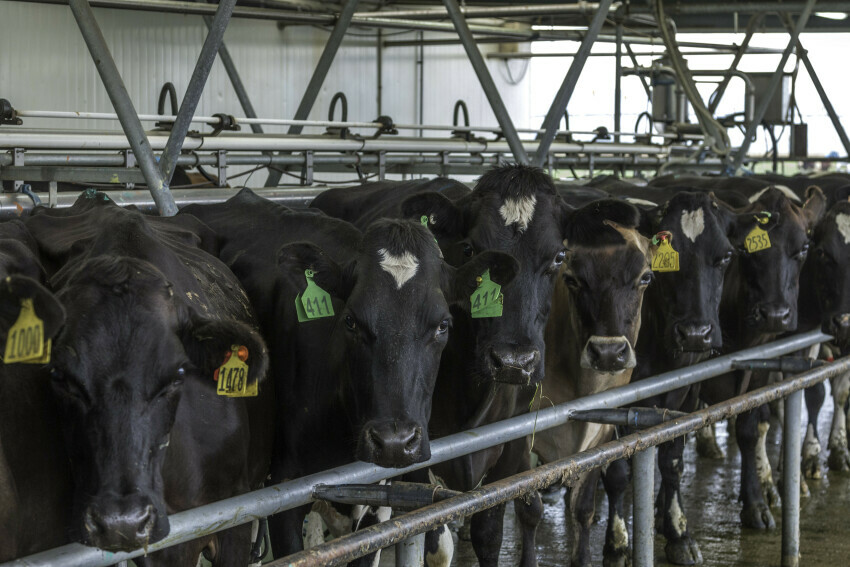The National-ACT-NZ First coalition was sworn in in late November 2023 – and wasted no time launching an all-out war on nature, unleashing a relentless onslaught of anti-environment initiatives. You can read a full breakdown of those here.
But just as swiftly – and in the true spirit of Aotearoa – the resistance began. New Zealanders stood up to defend nature.
From the deep south of Te Wai Pounamu to the top of Te Ika-a-Māui, people have come together to defend nature, our democracy and our founding document, Te Tiriti o Waitangi.
This Government is choosing to serve profiteering corporations – instead of the people they are elected to serve. But the resistance has taken root in every corner of the country. That should come as no surprise, because we are a country where courage is inherited, and standing up for what’s right runs deep in our bones.
Politicians who take money from polluting corporations, then rewrite the rules to serve those donors by gutting our democracy and environmental protections, may, like Shane Jones, call those who resist “blood-sucking vermin”. But we know who we truly are.
We are the country that first gave women the vote. That stood against apartheid during the Springbok Tour. The tiny nation that defied global superpowers and declared ourselves nuclear-free. That stopped native forest logging, kicked Big Oil out of the country’s waters, and gave legal personhood to the Whanganui river, Te Urewera forest and Taranaki mountain.
This is who we are. Even when the odds feel hopeless, as they sometimes do today in the face of the most anti-environment government in New Zealand history, people across Aotearoa have always found the courage to stand on the right side of history.
This timeline captures just some of the powerful and inspiring acts of resistance – marches, petitions, occupations, submissions, rallies, court cases and acts of civil disobedience – that are building a growing wave of opposition to this Government’s anti-nature agenda.
We’ve done our best to capture the acts of resistance – big and small – that make up this movement. But we know we’ll have missed some. If you spot something missing, please reach out – we’ll continue to update this timeline as the movement grows.
2023
21 October 2023: Hundreds of protesters gather in Aotea Square in Auckland, and other cities and towns, calling for a ceasefire in Gaza. Rallies against Israel’s genocide in Gaza continued to be held weekly across Aotearoa
2024
7 March 2024: The Government was met with immediate resistance to the introduction of one of its most appalling attacks on nature and democracy – the Fast Track Approvals Bill. On the very day they introduced the Bill (i.e the draft law), Greenpeace activists installed a giant tap pouring cow effluent outside the Beehive, highlighting how fast tracking more mega dairy dams would lead to more water pollution.
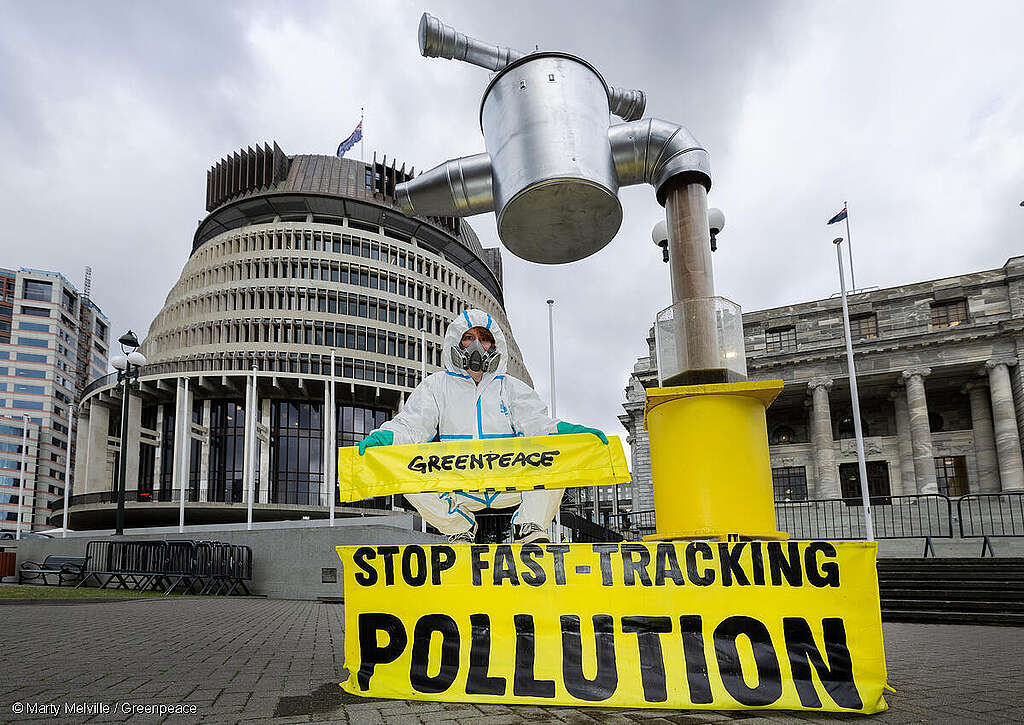
13 March 2024: In Taranaki a hearing reconsidering Trans-Tasman Resources (TTR’s) application to mine the seabed in the South Taranaki Bight was held. The Aussie mining company had tried and failed for more than ten years to get approval for its seabed mine. It was rejected repeatedly, including by the highest court in the land, the Supreme Court.
Local iwi and hapu, Greenpeace, Kiwis Against Seabed Mining, local communities, boaties, surfers, the fishing and offshore wind industries – all continued to stand strong against seabed mining and protesters gathered to make their opposition known to TTR and the EPA.
Within days, TTR had pulled out of the EPA hearings and gambled on the Luxon government’s freshly-announced Fast Track consenting process.
April 2024: The Fast Track Bill galvanised widespread and sustained opposition throughout Aotearoa. 27,000 people made submissions on the Fast Track Approvals Bill – with more than 90% opposed. In the same month, hundreds of kids went on strike from school and marched on Parliament to protest against climate change and the Fast Track Approvals Bill
There was a victory too. In Mangawhai-Pākiri, mana whenua and the local community fighting to stop offshore sand mining by McCallum Bros won a major case in the Environment Court – upholding the rejection of the company’s consent to continue dredging the coastline. It’s a powerful example of people power prevailing over corporate exploitation.
8 May 2024: Ngāti Toa marched on Parliament in opposition to the Fast Track Approvals Bill, delivering a box of submissions against the bill and performing the haka Ka Mate.
8 June 2024:Tens of thousands of people took to the streets of Tāmaki Makaurau on 8 June to protest against the Luxon government’s war on nature and the Fast Track Bill.
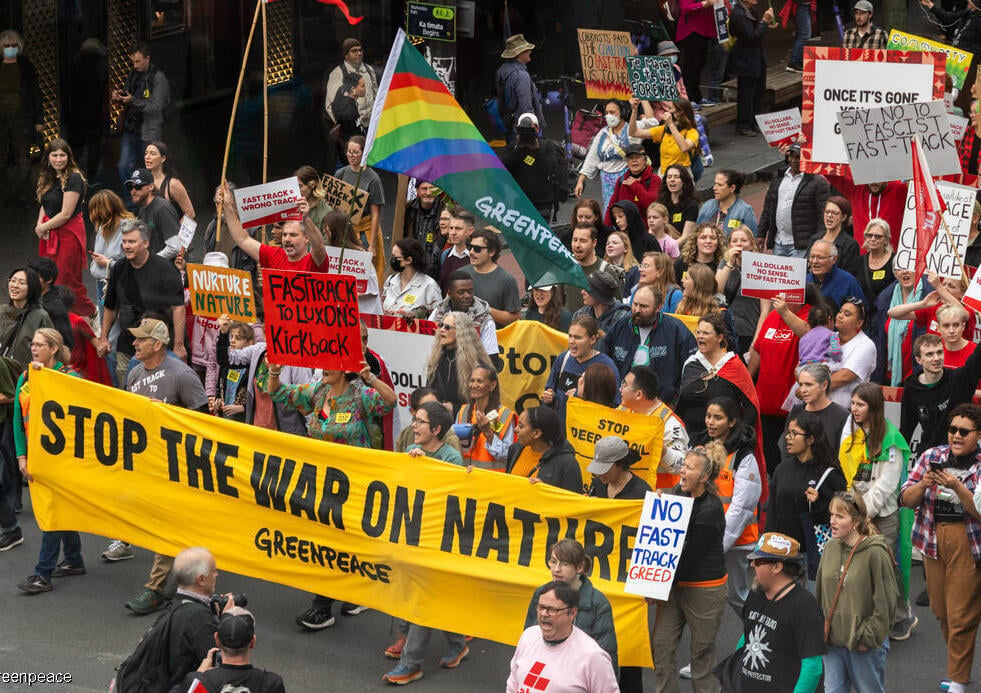
The Fast Track Bill originally aimed to give absolute power to three government ministers to approve individual consents. The loud widespread opposition to the Bill led to the government backing down on that issue, amendments to the Bill took decision-making power away from the ministers and gave them to expert panels.
26 August 2024: Around 100 people attend a hīkoi to wāhi tapu (sacred) Lake Rotokākahi in protest against the route of a sewerage pipeline. The pipeline’s path risks environmental damage to the lake and would desecrate a sacred or wāhi tapu area, where about 120 tipuna died in the Mt Tarawera eruption in 1886.
September 2024: In ongoing opposition to TTR’s proposed seabed mine and the threat it would be included in the Fast Track law, Greenpeace activists occupied the Wellington offices of mining lobbyist Straterra. The five activists drew attention to Straterra’s role in lobbying the Luxon government on behalf of TTR and other mining companies. Five activists were arrested, four of them convicted of trespass.
2 October 2024: Hundreds of locals marched through the small Taranaki town of Pātea, part of the growing protest against TTR’s proposed seabed mining just off the coast of Pātea.
9 October 2024: Greenpeace activists protesting the dairy industry’s climate pollution scaled Fonterra’s Te Rapa dairy factory unfurling a 160 square metre banner reading ‘Fonterra’s methane cooks the climate.’ ”
21 October 2024: The local community in Waimate continues to protest against a dangerous proposed fast track project, a waste incinerator that would burn 20 per cent of the South Island’s waste and release toxic pollution into the air. Since then, the Waimate incinerator company has hit fundamental obstacles in its bid to get fast track consent.
11 November 2024: The Hīkoi mō te Tiriti began in Northland in protest over the treaty principles bill, pushed by the ACT party which sought to unilaterally rewrite New Zealand’s founding treaty between Māori and the Crown. The Hīkoi gained momentum and people as it moved through Aotearoa.
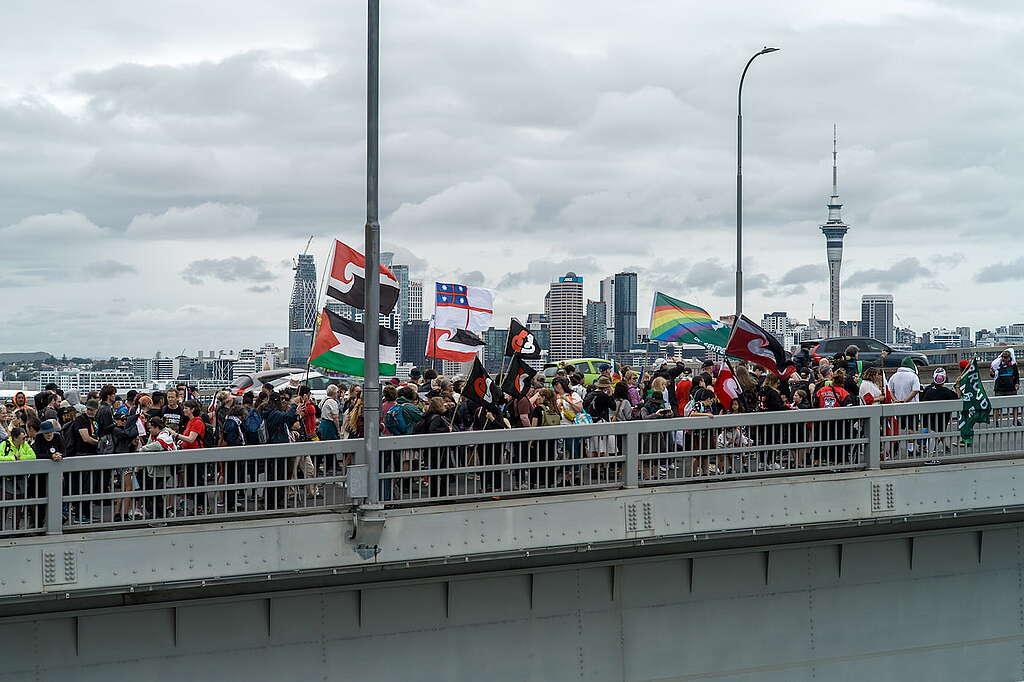 © Echo Valley / Greenpeace
© Echo Valley / Greenpeace19 November 2024: A historic day of mass protest in Aotearoa – the hikoi mō te Tiriti arrived in Wellington where tens of thousands of Māori, Pākeha and Tau iwi marched on Parliament demanding the Government honour Te Tiriti and scrap the Treaty Principles Bill.
7 November 2024: Another victory for the community opposing sand mining on Pākiri beach. They were awarded costs by the Environment Court of $500,000 which the company McCallum Bros has to pay. The award is among the largest-ever awarded by the court.
28 November 2024: Members of Taranaki iwi Ngāti Ruanui and Greenpeace activists took the campaign against seabed mining across the Tasman to Sydney. Rukutai Watene, Peeti Wharehoka-Watene and six Greenpeace activists interrupted the AGM of Manuka Resources, the owners of Trans-Tasman Resources and took the floor to outline the reasons the hapū opposed seabed mining in their rohe. The AGM was shut down.

3 December 2024: The Fast Track Bill continued to spark protests. University students in Wellington marched against the Bill. Organisers said the bill would allow the government to make decisions about the sustainability of young people’s futures without giving them a say.
2025
14 January 2025: Submission period closes on the Treaty Principles Bill with a record breaking 300,000 public submissions made, with 90% opposed to it.
26 January 2025: 1500 people rallied at Ruakākā Beach in Northland against a fast track proposal to extract up to 8 million cubic metres of sand from the Bream Bay seabed. The same company behind the failed attempt to continue sand mining in Mangawhai-Pākiri, McCallum Bros are the company trying to secure this fast track consent.
31 January 2025: Protests continue against the Fast Track – Minister for mining Shane Jones was greeted by protesters in Waihi as he announced coal and gold would be added to the critical minerals list. The announcement highlighted the Luxon government’s obsession with filthy fossil fuels and its desire to turn Aotearoa into a country full of open-cast mines.
25 February 2025: Lake protectors from the Protect Rotokākahi group occupied the site of a proposed controversial pipeline at Lake Rotokākahi in Rotorua, preventing construction from beginning. Seven people were arrested for refusing to move.
3 March 2025: Protesters climbed onto the Rolleston building of an international weapons company NIOA, which has links to the Israeli Defence Force in Gaza, demonstrating against its New Zealand expansion.
16 March 2025: A flotilla of more than 50 watercraft converged from Whangārei Heads to Langs Beach to oppose the proposed fast track sand mining project in Bream Bay.
6 April 2025: Greenpeace activists occupied part of Port Taranaki to protest against the use of palm kernel expeller (PKE) in New Zealand dairying. They locked themselves in the building while others attached a 70-metre banner reading ‘Anchor Rainforest Killer’ to the roof. PKE is used as a cow feed on Fonterra farms and is linked to illegal palm plantations and deforestation of paradise rainforests in Southeast Asia.
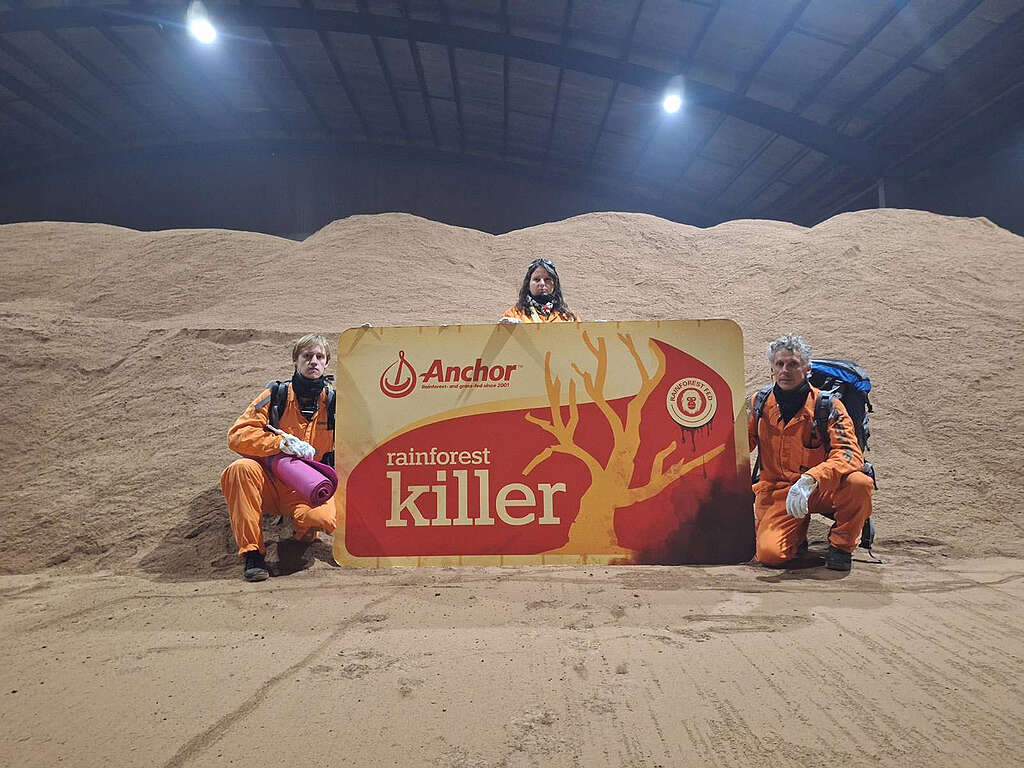
10 April 2025: Another win. The Treaty Principles Bill is resoundingly rejected and voted down by all political parties, except for ACT.
20 April 2025: Seventy people occupied the site of a proposed fast-tracked coal mine on the unique and fragile Denniston Plateau, home to many endangered species. The protesters occupied the site for many days and vowed to continue to take action against the mining company, Bathurst Resources, if it tried to expand its coal mine operations in the area.
26 May 2025:A win! The Environmental Defence Society secured a procedural Fast Track win – forcing the EPA to publicly release all information provided to it without delay. Previously, the EPA only published fast track application information once it was deemed complete and within scope.
6 May 2025: Charges were dropped against climate protesters after the jury could not reach a unanimous decision. The protestors had staged sit downs and stuck their hands to roads in Wellington, abseiled above Mount Victoria tunnel and hung banners above State Highway 1.
16 May 2025: More than 3,100 submissions are made on the Government’s plans to increase minimum residue levels for glyphosate by a 100-times on wheat, barley, and oats. Not a single submission supports the proposal.
23 June 2025: 159,000 people submitted on the ACT Party’s Regulatory Standards Bill, dubbed the Treaty Principles Bill 2.0 and widely opposed across civil society. A number second only to the submissions against the TPB. 98.7% of submitters are opposed to the Bill which was condemned as a threat to democracy, the treaty and the environment. The Bill seeks to impose a set of the ACT party’s principles on future lawmakers that explicitly exclude the Treaty, equity and environmental protections and instead prioritise corporate property rights above all else. The Bill also seeks to create a new unprecedented expectation that the Government compensate corporations if regulations designed to protect people or nature affect their profits.
10 June 2025: Across the North Island, over a thousand people took to the beaches and hundreds take part in a paddle out into the ocean to protest Seabed mining
28 June 2025: Greenpeace activists confronted Talley’s bottom trawler Amaltal Atlantis on the Chatham Rise, painting the message “ocean killer” on its hull. When heavy trawl nets are dragged across the seafloor and over seamounts, they bulldoze ancient corals and kill precious marine life including fur seals, dolphins and seabirds.
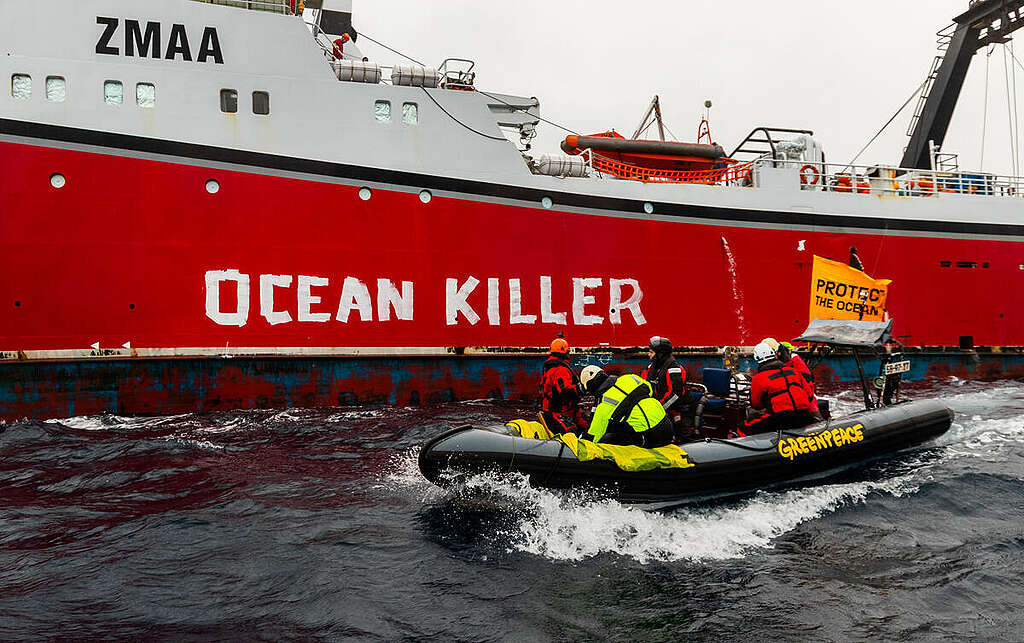
17 July 2025: The Hauraki Gulf Alliance called again for a bottom trawling ban in the Hauraki Gulf. They deployed a massive ‘Ban Bottom Trawling’ banner on the deck of the Rainbow Warrior, demanding an end to destructive bottom trawling in the Hauraki Gulf Marine Park.
23 July 2025: Greenpeace activists give Gore’s iconic brown trout statue a makeover in protest after residents of Gore were issued a do-not-drink notice after their town water supply exceeded the legal limit of 11.3 mg/L of nitrate contamination.
27 July 2025: Two brave climate activists set up home in a coal bucket on Stockton Mine’s aerial ropeway in protest against Bathurst Resources application under the Fast Track process to carry out more mining on the Denniston Plateau. They spend three weeks in the buckets, braving bracing conditions, and corporate intimidation tactics.
8 August 2025: Climate activists protest outside ANZ banks nationwide and shut down the Dunedin branch. They were protesting against ANZ lending to coal mining corporation Bathurst Resources which is attempting to get fast track consent to mine the Denniston Plateau.
16 August 2025: Northlanders gathered in Whangārei to confront Shane Jones over two wildly opposed fast track projects: the Bay of Islands Marina and the Bream Bay sand mining.
12 August 2025: A win! The Environmental Protection Agency declined to send the Te Kuha coal mine down the fast track process, after it failed to meet seven of the application criteria. The environmentally destructive proposal had already been rejected multiple times by courts, including the Supreme Court.
12 August 2025: A shark and a dolphin got into the Seafood NZ conference in Nelson to deliver a strong message to the that more ocean protection was needed.
23 August 2025: Greenpeace activists board a Talley’s fishing vessel in Nelson in protest against bottom trawling. The three activists were arrested after unfurling a banner reading “Ocean Killer”.
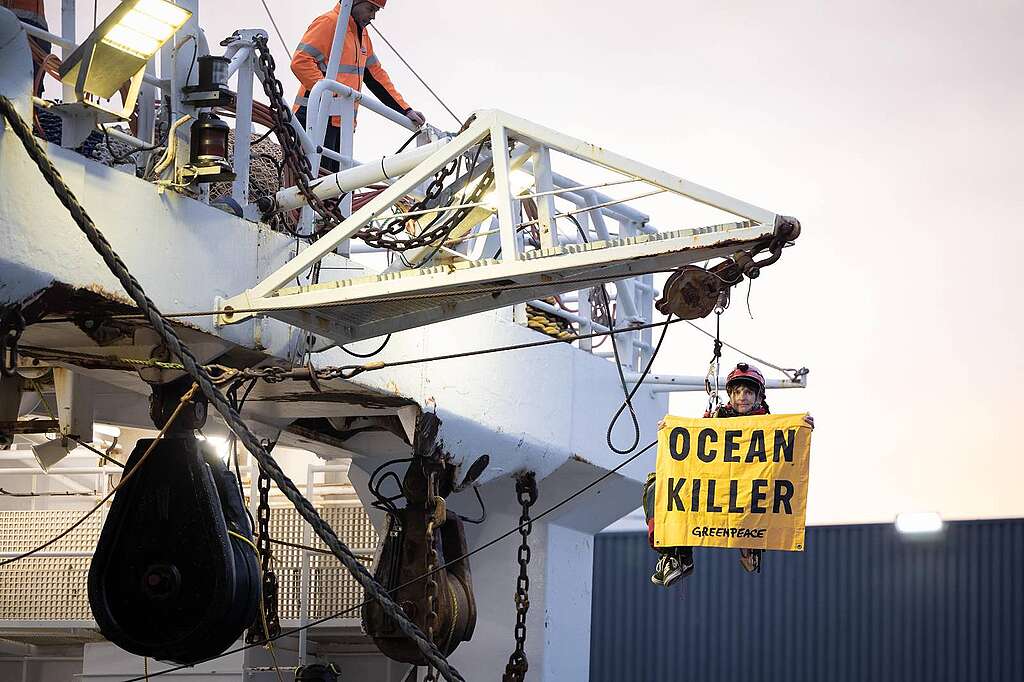
9 Sept 2025: Greenpeace projected images of destroyed coral onto a Wellington building, ahead of an international fisheries meeting.
13 September 2025: 20,000 people march through Auckland in a March for Humanity, calling for a ceasefire in Gaza and sanctions to be imposed on Israel.
15 September 2025: Six Christian clergy chained themselves to Finance Minister Nicola Willis’ electorate office in Wellington and refused to move for 32 hours in protest against the slaughter of civilians in Gaza.
17 September 2025: Cantabrians rallied outside Environment Canterbury (ECan) protesting against nitrate contamination as a result of intensive dairy farming. On the same day, another win! ECan declared a Nitrate Emergency in Canterbury.
29 September 2025: Greenpeace projected a message onto the New Zealand stock exchange building in Wellington as Manuka Resources announced it was listing on the NZX. The message warned New Zealand investors and financial institutions to boycott Manuka Resources and not to bankroll its destructive seabed mining project in the South Taranaki Bight. A new petition warning companies was launched to coincide with the projection.
3 October 2025: ‘Nitrate emergency starts here’ – a freshly-installed Fonterra farm sign is installed outside Canterbury’s first completed dairy conversion of 2025. Despite the council declaring a nitrate emergency, Government rollbacks on freshwater laws have allowed dairy conversions to resume.
10 October 2025: A win! Waikato Regional Council advanced its plan to close the vast majority of the Coromandel’s coast to bottom trawling fishing.
7 October 2025: A win (with reservations)!! The Hauraki Gulf Protection Bill passes law – a significant milestone for ocean protection. But bottom trawling and commercial fishing operations were still permitted in most areas.
13 October 2025: Another win! After facing fierce opposition, NZ First announced it will not support the Gene Tech Bill – the government’s proposal to radically deregulate genetic engineering and GMOs. Without NZ First’s support, the bill is dead in the water.
16 October 2025: Veteran Māori rights activists delivered a 20,000 strong petition against the Marine and Coastal Area (Takutai Moana) Act (MACA). The Act seeks to rob Māori of customary rights to the marine and coastal area and has been condemned as tantamount to raupatu or confiscation, Just days later on 20 October 2025, protestors across the country take to the beaches and burn copies of the bill in protest.
28 October 2025: Workers, unions, and iwi gathered across the motu for Rā Whakamana, a nationwide day of solidarity between iwi and unions calling on the government to honour Te Tiriti.
30 October 2025: Ngātiwai travelled to Aorangi and Tawhitirahi (Poor Knights Islands) aboard their waka hourua to raise their flags and erect a pou whenua rejecting the Crown’s continued attempts to raupatu their takutai moana through the recently passed amendments to the Marine and Coastal Area (Takutai Moana) Act (MACA).
30 October 2025: A win! The Government backs down on its proposal to permit the hundredfold increase in the allowable residue of glyphosate on wheat , oats and barley.
20 November 2025: A win – or is it an own goal? NZ First leader Winston Peters pledges to repeal ACT’s Regulatory Standards Bill – only two days after his party voted for it in parliament! Cue accusations from David Seymour that Winston Peters is planning to go with Labour at the next election.



